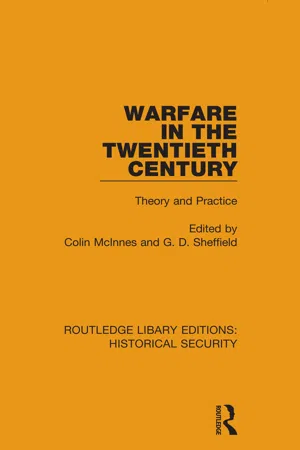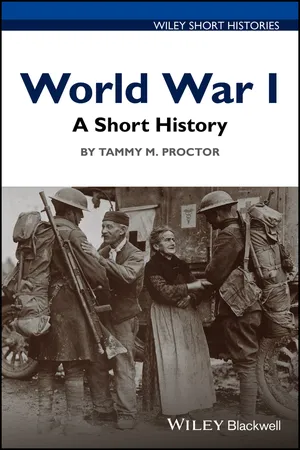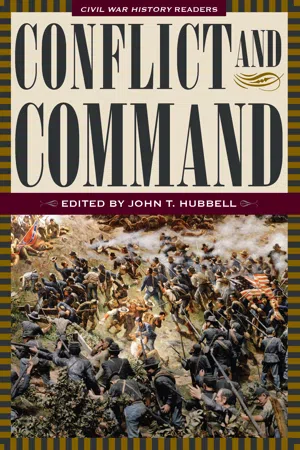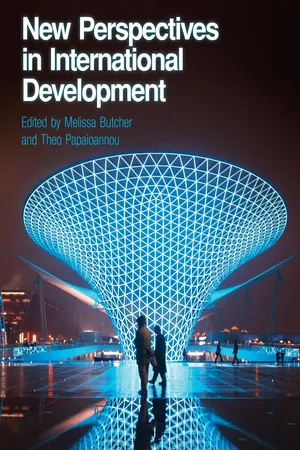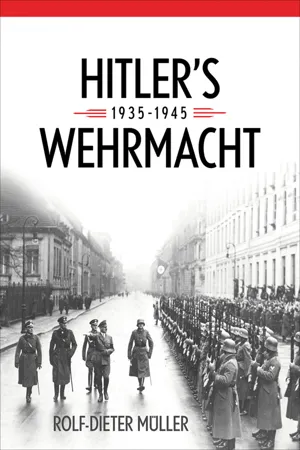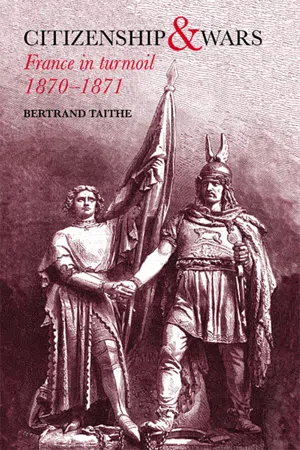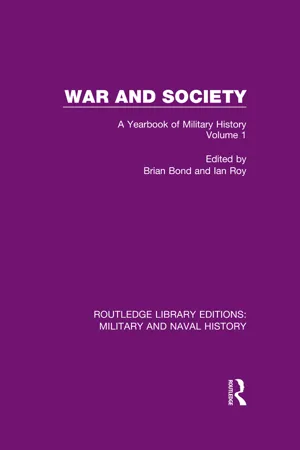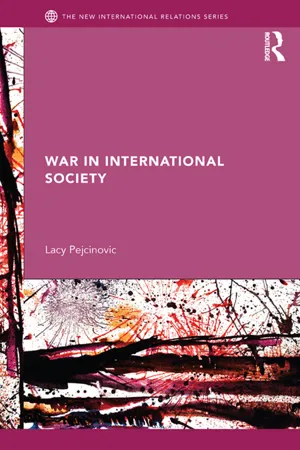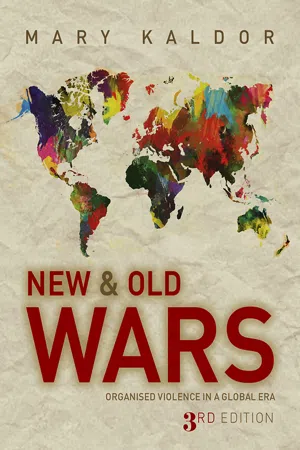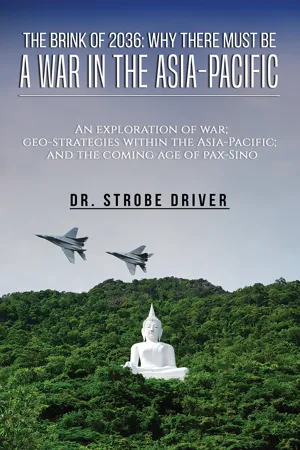History
Total War
Total war refers to a conflict in which a nation mobilizes all of its resources, including its civilian population, to support the war effort. This concept emerged during the 19th and 20th centuries and was characterized by the widespread involvement of society in warfare, including economic, industrial, and ideological aspects. Total war often leads to significant social and political changes within the participating nations.
Written by Perlego with AI-assistance
Related key terms
Related key terms
1 of 4
Related key terms
1 of 3
11 Key excerpts on "Total War"
- eBook - ePub
Warfare in the Twentieth Century
Theory and Practice
- Colin McInnes, G. D. Sheffield(Authors)
- 2021(Publication Date)
- Routledge(Publisher)
1Total War
Ian F. W. BeckettThe historiography of Total War
In the last twenty years, historians have come increasingly to recognize the often pivotal role played by war and conflict in historical developments. In the process, the interpretation and understanding of the impact of war upon states, societies and individuals have been transformed. In particular, the concept of ‘Total War’, as applied to the two world wars of the twentieth century, has become a familiar one and a matter for modern historiographical debate. Generally, the term ‘Total War’ is used by historians not only to describe the nature of the world wars but also to differentiate such wars from other conflicts. The study of Total War within the context of war studies or studies of war and society is largely a product of the 1960s, but the term itself is older. Ludendorff appears to have used the term first in his memoirs, published in 1919, but it was also employed in a ritualistic fashion during the Second World War. Josef Goebbels, for example, threatened the Western Allies with ‘Total War’ in a celebrated speech in February 1943 and was himself appointed Reich Plenipotentiary for the Mobilization of Total War in July 1944; Winston Churchill also used the phrase in an address to the United States Congress in May 1943. Now, the term has become almost synonymous with the concept of war as a catalyst of far-reaching social change, and it is in precisely that sense that Total War is a subject of continuing historical debate.The American scholar, J. U. Nef, whose War and Human Progress was published in 1950,1 may stand perhaps as representative of an earlier period of historiography, when war was regarded as having a purely negative impact, in so far as it was at all relevant to historical development. However, there were other scholars in the 1950s whose work was suggestive of the future approach to the question of war and social change. Richard Titmuss made a connection in 1950 between the two in his volume, Problems of Social Policy, for the British official history of the Second World War2 while Stanislas Andrzejewski offered the ‘military participation ratio’ in 1954,3 which postulated a firm correlation between the extent of wartime participation by society in the war effort and the amount of subsequent levelling of social inequalities. The English historian, G. N. Clark, also produced during the 1950s a pioneering study of war and society in the seventeenth century,4 but the real broadening of historical perspectives with regard to what became known as war studies came in the following decade. A comparison of Michael Howard’s classic military history of the Franco-Prussian War, published in 1961,5 with his War in European History 6 - eBook - ePub
World War I
A Short History
- Tammy M. Proctor(Author)
- 2017(Publication Date)
- Wiley-Blackwell(Publisher)
The Total War (1935). Ludendorff, of Tannenberg fame, described World War I in hindsight, but it is important to remember that the concept of Total War he explained was designed for future use. Looking back, after almost two decades, on Germany’s defeat in World War I, Ludendorff argued that Clausewitz’s ideas about war were outdated and obsolete. Instead, World War I had started a process that would culminate in a successful war of the future, namely one in which a nation’s military would wage war on the total society of its opponent. Total War relied on annihilation and extermination of the enemy population for total victory to be achieved. Every citizen of the enemy nation was a target in this conception of war, and every resource that could be mobilized for the war effort should be activated. Therefore, in Ludendorff’s description, Total War meant turning all the nation’s peoples, industries, political mechanisms, armed forces, and land into a huge military camp. Only when that process had been completed would the mass national effort be launched against every man, woman, and child in the enemy nation.Ludendorff’s term “Total War” became the focus of scholarly debate in the period after World War II, a conflict that seemed to fit Ludendorff’s discussion. Historians in this debate defined Total War in a variety of ways as they worked with the concept. First, Total War could mean state control of society for the purpose of waging war, and often total mobilization of humans and resources becomes a stated goal. Second, Total War could describe a state’s war aims, which might range from unconditional surrender to total destruction of an enemy. Finally, Total War sometimes is used to outline a state’s principles of war, typically violations of shared conventions of what is considered a “just” or “moral” war. Taken together, these features of Total War suggest a conflict that breaks the boundaries of past behavior and that encompasses the majority of people in a state. In other words, Total War refers to a “radicalization of warfare” and a “complete mobilization” of resources.Was World War I such a war? Did the nation‐states of 1914 to 1918 effectively mobilize all their people and resources then pursue policies and strategies that ruthlessly targeted enemy populations? The answer is a qualified one. States employed strategies of Total War throughout the period from 1914 to 1918 and indeed in the conflicts that followed, but a truly Total War remained an impossibility for most of the nations. To truly mobilize all people and resources required a measure of organization and funding that was difficult to attain. The rest of the chapter will look at the ways in which war assumed the trappings of a total mobilization of people and resources, a “Total War” mentality, while also outlining the obstacles and limitations of this concept. - eBook - ePub
Conflict and Command
Civil War History Readers, Volume 1
- John T. Hubbell(Author)
- 2011(Publication Date)
- The Kent State University Press(Publisher)
From the start, it meant the obverse of that idea as well: making war on the economic resources of the enemy rather than directly on its armed forces alone. Yet there was nothing really new about attacking an enemy’s economic resources; that was the very essence of naval blockades and they long predated the Civil War. The crucial and terrible new aspect of the notion of Total War was embodied in the following idea, part of a definition of the term cited in the Oxford English Dictionary: “Every citizen is in a sense a combatant and also the object of attack.” Every systematic definition of the term embodies the concept of destroying the ages-old distinction between civilians and soldiers, whatever other ideas may be present. Another citation in the OED, for example, terms it “a war to which all resources and the whole population are committed; loosely, a war conducted without any scruple or limitations.” Webster’s. . . Unabridged dictionary describes Total War as “warfare that uses all possible means of attack, military, scientific, and psychological, against both enemy troops and civilians.” And James Turner Johnson, in his study of J ust War Tradition and the Restraint of War, asserts that in Total War “there must be disregard of restraints imposed by custom, law, and morality on the prosecution of the war. Especially,. . . Total War bears hardest on noncombatants, whose traditional protection from harm according to the traditions of just and limited warfare appears to evaporate here.” 13 Close application of this twentieth-century term, the product of the age of strategic bombing and blitzkrieg and powerful totalitarian governments capable of mobilizing science and psychology, to the Civil War seems fraught with difficulty - eBook - ePub
- Melissa Butcher, Theo Papaioannou(Authors)
- 2013(Publication Date)
- Bloomsbury Academic(Publisher)
That is, war is seen as an instrument of political action, used by the leaders of states to attain identified goals, whether that be taking territory (as with the Iraqi invasion of Kuwait), reducing an enemy’s military power, or some other specific strategic, political, economic or cultural goal. For Mann, war in this phase was limited in goals – what war aimed to achieve – and in the means used – the size of armies or weapons technology used. It was also limited in terms of the extent to which society as a whole was involved in warfare. Limited wars often drew on a small proportion of the population to do the fighting, while declaring war, formulating strategy and concluding peace deals were mainly decided by aristocratic and political elites. Wars of this kind were also typically of short duration. Many of these wars involved territorial expansion in the context of colonialism, such as the Boer War (1899–1902). As you will see in Subsection 2.2.2, even in this phase, for some historians, warfare had a very major developmental impact on the European states involved. Mann suggests the second phase of warfare is Total War, exemplified by the period of the two World Wars (1914–18 and 1939–45). Total War was unlimited in its goals – the aim was the complete destruction of the opponent. It utilized increasingly destructive and mobile forms of technology through the ‘industrialization’ of warfare, and the constant revolutionizing of the means of war through the application of industrial science and technology. In these wars, the whole manufacturing sector of respective states often became devoted to weapons production or forms of military support, such as medical supplies, aeronautics and communication. As a result, Total War also drew in ever greater numbers of people, eventually seeking the total mobilization of societies through mass conscription and the diversion of economic output to achieve war ends, as was the case, in particular, in World War II - eBook - ePub
- Rolf-Dieter Müller, Janice W. Ancker(Authors)
- 2016(Publication Date)
- The University Press of Kentucky(Publisher)
6Total War and the War of Annihilation
The Changed Image of War
The First World War is commonly viewed as the earliest manifestation of Total War; the Second World War, as Total War at its peak. The term “Total War” refers to an all-out effort for the sake of war, that is, an entire society’s mobilization for war to the point of exhaustion. It means eliminating the boundaries of political war objectives, which carries the potential to destroy entire countries and populations. It means defining the war in ideological terms, dehumanizing the conduct of war, and using modern technology and science for military purposes.The conduct of Total War from 1914 to 1918 acknowledged certain boundaries and, to some extent, respected traditional conventions and issues. The populations of some major powers were so overextended by the war that their social and political structures became dysfunctional, revolution occurred, and they did not survive the war. After 1918, traumatized by the industrialized character of the war—with its mass battles of modern armies of millions—some countries searched for new restrictions on war in keeping with international law. Others searched for the means and strategies to prevent the escalation of a future war. In Germany, many experts were convinced that any future war would necessarily lead to Total War for Germany—that is, to a “fight for existence” as a people—for which they had to prepare themselves intensively. Hitler and his regime drew a large portion of their political ideology from this belief.The Second World War did not begin as a Total War, although the entire world had expected it to. Only under the pressure of defeats and serious threats did the modern industrial societies turn to the tasks of equipping themselves for war, militarizing their civilian societies to the necessary degree, and preparing them for possible sacrifices. Contrary to earlier assumptions, the democracies proved they were not at all inferior to the totalitarian dictatorships. Moreover, they were in a better position to channel their energies toward the war and, once the battles were over, to quickly direct these energies back onto civilian paths. This was due to their ability to respond positively to pressure from below, to give in to demands for the inclusion of the “masses,” and to respond to the postwar expectations of soldiers and citizens. For Stalin and Hitler, in contrast, the war was a means to strengthen their dictatorships and transform society for the purpose of creating and selecting a “new” kind of human being. - eBook - ePub
- Antonín Basch(Author)
- 2021(Publication Date)
- Routledge(Publisher)
HAPTER II WAR ECONOMYEconomic Impact of Total War
T HE economic impact of Total War between great nations with a developed national economy is of such proportions and intensity as to interfere with all items of economic life. For it transforms peace economy into war economy, of which the one prevailing purpose is support of actual military warfare. Economic forces and adjustments have steadily assumed a more important role in the great wars of the twentieth century. The nature of modern Total War has minimized the distinction between the fighting forces and civilian population.1The single task of the war economy takes both a constructive and a destructive form. It involves, on the constructive side, supplying the fighting forces with the maximum of goods and services in the shortest possible time. In this effort it must, to the fullest possible degree, preserve justice in the distribution of sacrifices and avoid economic dislocation and disruptions which may impede the post-war reconstruction. In its destructive phase—which is economic warfare proper—it must weaken and damage as much as possible the potential and active economic strength of the enemy. It is obvious then that economic considerations such as the profit motive, competition, market price laws, and private economic sovereignty must be subordinated to the nation’s primary aim.1 “Whether fighting, working, or contributing capital, everyone has to bring forward every bit of reserve to help the nation toward victory.” Carl Joachim Friedrich, “Totalitarian War,” in Plan Age (May 1940), p. 162.Within the limits set by the available human and material resources, the dimensions of the efforts and sacrifices which the nation must make are dictated by the intensity of the aggressor’s war effort. In this relationship the factors of time and of preparedness are of great importance. The essential structure of war economy is the same in totalitarian and in democratic countries, and inherent in all are certain common principles of function. In the modern war economy we must part with traditional monetary conceptions and consider the terms of real economy. Such procedure makes more clear the importance of the war economy’s structure and operation. - eBook - ePub
Citizenship and Wars
France in Turmoil 1870-1871
- Dr Bertrand Taithe, Bertrand Taithe(Authors)
- 2003(Publication Date)
- Routledge(Publisher)
In a recent collection devoted to this subject, historians failed to find a common historical register to discuss the issue of Total Warfare. 11 Part of this problem comes from the work of Clausewitz himself, who, writing in the 1820s, could not have anticipated the destructive industrial warfare of attrition of the Western Front in 1914–18, but could reflect on the mass wars of the revolutionary period. The notion of Total War is thus less associated with the means of war— industry need not be part of the equation if the parties involved are devoid of industrial strength—and more with war objectives. Total Wars of the revolutionary period seem to imply a war to the last, intent on destroying the enemy's military might, its political system or even its culture. Uncompromising war aims would thus term war as the opposite of diplomacy, carried through other means. If we analyse the Franco-Prussian war, it soon becomes obvious that some of its features make it relatively close to a Clausewitzian type of war. Since we are still talking about theoretical models and a conceptual typology, it is obvious that the relationship between theory and practice may be quite problematic. In 1870, the war effort on the part of the French gradually stepped up and became almost universal. The first mobilisation effort had recruited all soldiers, including reserves and others. In August the mobilisation was applied to all single men under the age of 40 - eBook - ePub
War and Society Volume 1
A Yearbook of Military History
- Brian Bond, Ian Roy(Authors)
- 2015(Publication Date)
- Routledge(Publisher)
Total War in the Twentieth Century: Participation and Consensus in the Second World War Michael HowardIn 1925 the University of London sponsored a series of lectures by distinguished civil and military leaders with the title The Study of War for Statesmen and Citizens. 1 This course was designed to bring home to the general public the extent to which war had become a matter, not simply for military specialists, but for society as a whole. The experience of what was still known as The Great War had shown that in the twentieth century wars had to be fought with the full resources of the entire community. Even in the midst of the profoundest peace societies thus had to be conscious of the possible demands which a future war might make on those resources and be prepared to meet them. The emphasis therefore was on the measures which the community might have to adopt, the sacrifices it might have to make, the dangers it might have to undergo, if war were ever to occur again. But as yet there was no serious academic study of the way in which society itself would be transformed, and indeed had been transformed, by the demands of Total War. The material for such a study had existed, at least for Great Britain, in the remarkable collection of documents collected and housed by Miss Caroline Playne in the University of London Library, which provided the basis for her own pioneer studies.2 For other nations monographs of uneven quality had been produced under the auspices of the Carnegie Endowment for International Peace.3 But none of this was yet made the basis for any sustained or coherent scholarly examination.The Second World War awoke a new interest in the relationship between war and social change. Not only did it accelerate, within all the societies involved, the processes of change catalysed by the Great War, but it brought social involvement in belligerent activity to a new level of intensity by eliminating the distinction between ‘front line’ and ‘base’. This distinction had characterised not only the 1914-18 war but the great majority of wars in Europe since the seventeenth century. During the First World War heavy and prolonged pressures had been brought on civilian populations to find vast and continuous resources of men and material for the Front – a word which itself became heavy with sombre meaning – and these pressures were in themselves highly catalytic of social change.4 But the pressures arising from a situation in which the Front was everywhere , whether because of air bombardment as in Britain, Germany and Japan, or because of invasion and occupation as in continental Europe and the Soviet Union, were of a different order of magnitude altogether. It has taken us a generation to get these pressures into perspective and perhaps we have not done so yet. Certainly the experience made it difficult for anyone involved in them to maintain the serene assumption of the Enlightenment that war had not been a major factor in social development but a barbarous aberration which man had outgrown. It also made it difficult to believe, however wrongly and pessimistically, that it would not in some form or another continue to be so.5 - eBook - ePub
- Lacy Pejcinovic(Author)
- 2013(Publication Date)
- Routledge(Publisher)
The twentieth century was alive with wars from which to draw interpretations that could feed into an understanding of it as a social institution of international society. An obvious place to begin is the world wars which saw Germany twice pitted against the broader international society in wars that were socially, politically, militarily and economically ‘total.’ As a concept, ‘Total War’ has significant resonance and as a general idea can be said to apply to any war because the idea of war involves the destruction of not only military forces, but inevitably the social and political entities involved. However, here the concept is used more explicitly to refer to the broad ‘political and cultural’ as well as destructive context of war. It refers to the ‘complete mobilisation of a society’s resources to achieve the absolute destruction of an enemy, with all distinction erased between combatants and non-combatants’ (Bell 2008; 7). However, both world wars were justified in ways reminiscent of the great power wars of the nineteenth century, where internal political identity, the balance of power, and the necessity of protection against illegitimate political and social structures justified war and made it an institution of international society. These general justifications promoted in the historical literature, each reflecting an interpretation of the unacceptable militarism of members of international society and the reality of the changing balance of power or equilibrium, demonstrate this connection to the nineteenth century.The first argued that the war was inevitable, unavoidable due to the spiralling security and defence conditions compounded together in a short amount of time. The second justification focused on domestic pathologies leading to an embedded aggressiveness in certain states, but also domestic or internal crises as justification for war. Finally, there are systemic level justifications which highlight the role of multi-polarity and entangling alliances (Copeland 2000; 8). In reality, it is a complex combination of these factors which produces a holistic picture of the justifications for World War I. The Germans used the assassination of the Archduke and his wife to encourage Austria to launch an attack on Serbia. The Kaiser, a well-known friend of the Archduke, was deeply saddened by his fate and what it represented for the monarchical identity at the heart of European equilibrium. At the same time, though, a constant fear of a rising Russia coupled with an immediate military superiority influenced their involvement (Joll 1992 and Copeland 2000). Ebba Dahlin (1933; 5) reflects the elements of identity and necessity reminiscent of the nineteenth century when she comments that, ‘In the historic session of the German Reichstag on August 4, 1914, the Kaiser and the Imperial Chancellor von Bethmann-Hollweg declared that the “empire unsheathed the sword to wage war of national defense.” The imperial government then stated specifically that its aims were to conserve the dual monarchy, to maintain the position of the Teutonic race in Europe, and to defend Germany against Russia.’ - eBook - ePub
New and Old Wars
Organised Violence in a Global Era
- Mary Kaldor(Author)
- 2013(Publication Date)
- Polity(Publisher)
2 Old WarsAs Clausewitz was fond of pointing out, war is a social activity.1 It involves the mobilization and organization of individual men, almost never women, for the purpose of inflicting physical violence; it entails the regulation of certain types of social relationships and has its own particular logic. Clausewitz, who was arguably the greatest exponent of modern war, insisted that war could not be reduced either to art or to science. Sometimes he likened war to business competition, and he often used economic analogies to illustrate his points.Every society has its own characteristic form of war. What we tend to perceive as war, what policy makers and military leaders define as war, is, in fact, a specific phenomenon which took shape in Europe somewhere between the fifteenth and eighteenth centuries, although it has passed through several different phases since then. It was a phenomenon that was intimately bound up with the evolution of the modern state. It went through several phases, as I have tried to show in table 2.1 , from the relatively limited wars of the seventeenth and eighteenth centuries associated with the growing power of the absolutist state, to the more revolutionary wars of the nineteenth century such as the Napoleonic Wars or the American Civil War, both of which were linked to the establishment of nation-states, to the Total Wars of the early twentieth century, and the imagined Cold War of the late twentieth century, which were wars of alliances and, later, blocs.Table 2.1 The evolution of old warsEach of these phases was characterized by a different mode of warfare, involving different types of military forces, different strategies and techniques, different relations and means of warfare. But, despite these differences, war was recognizably the same phenomenon: a construction of the centralized, ‘rationalized’, hierarchically ordered, territorialized modern state. As the centralized, territorialized modern state gives way to new types of polity emerging out of new global processes, so war, as we presently conceive it, is becoming an anachronism. - eBook - ePub
The Brink of 2036: Why There Must Be a War in the Asia-Pacific
An exploration of war; geo-strategies within the Asia-Pacific; and the coming age of pax-Sino
- Dr. Strobe Driver(Author)
- 2024(Publication Date)
- Austin Macauley Publishers(Publisher)
To clarify the state-of-affairs alluded to by Osgood, there was never a chance North Vietnam would ever have been able to constitute a threat to the USA and thus, by entering the limited war highlights the drastic shortcomings in the use of limited war as a strategy of intervention on the part of the USA; and as a tool-of-persuasion. There are and have always been substantial dangers of engaging in a war, in more than one war, or a war far from a home base. Nevertheless, the perils of entering into a limited war has never it seems, discouraged powerful nation-states from doing so. This is due to the advantages of limited war outweighing the disadvantages as—and as shown by Britain, the USA and France—even if a war ends in stalemate from a military perspective the advent of greater politico-influence in a region remains and possibly is enhanced, because it sends a message of being capable and proficient in the use-of-force. Thus, limited war has remained vibrant.What the above narrative has sought to shed light upon, is the interweaving and sometimes colliding components that take place are able to be viewed through a prism of advantage; to bring to light aspects which influence decision-makers in how far to advance or retard a war, whilst attempting to keep it within an ascribed notion of what ‘limited’ comprises ‘of’. With this in mind, it is necessary to acknowledge the subjectiveness of the term and to observe the term, in and of itself, remains largely within the remit of what a powerful actor deems to be ‘limited’. Beyond the aforementioned remit however, what constitutes ‘total’—how much of the populace needs to be involved as per the ‘high mobilisation’ aspect ascribed to by Vasquez—to a certain extent means observing what the war is ‘becoming’, and therefore, at what point it becomes total is also somewhat interpretive.The end result of a Total War is definitive, the argument here is when does a war ‘drift’ from limited to total, the interpretive aspect is that belligerents’ opinions would differ. The interpretative aspects accepted and further understanding in the post-WWII era, many nation-states have embarked upon limited wars and as remarked upon earlier, no war has evolved beyond the limitations imposed and as such the limited wars that have taken place within the stipulated timeframe have remained ‘limited’. From this standpoint, it must be further acknowledged that the term ‘limited’ whilst being interpretative also has within it inherent tensions. One can safely argue however, an efficient way to observe the ascribed tensions is to analyse, albeit briefly, a war which would throw up these tensions and in doing so deliver a further comprehension that the most powerful belligerent whilst having what is able to be measured as overall advantage, does not necessarily have the capacity to exploit said advantage.
Index pages curate the most relevant extracts from our library of academic textbooks. They’ve been created using an in-house natural language model (NLM), each adding context and meaning to key research topics.
Explore more topic indexes
Explore more topic indexes
1 of 6
Explore more topic indexes
1 of 4
